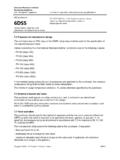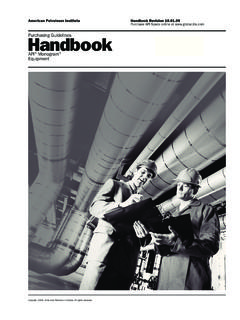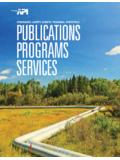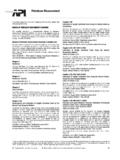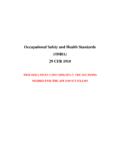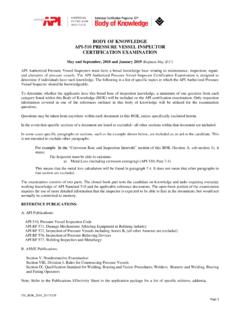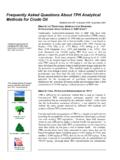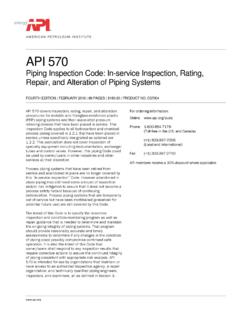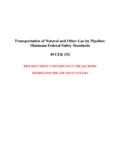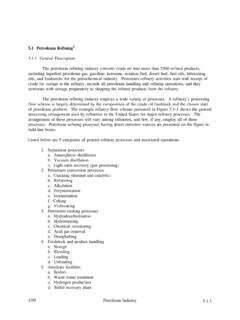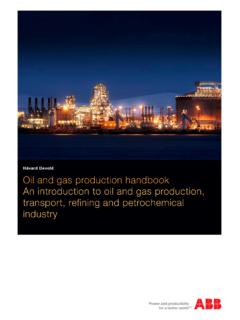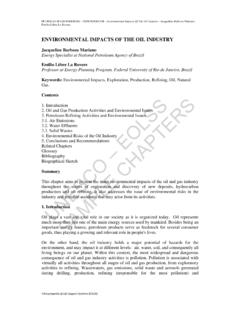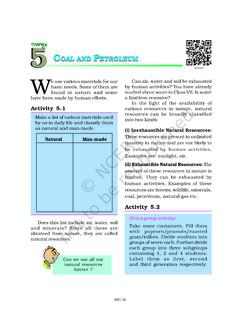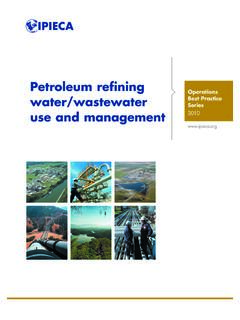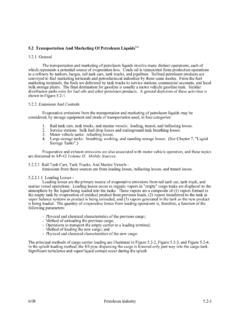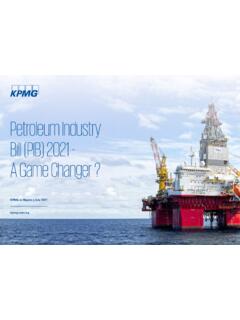Transcription of American Petroleum Institute Guide to Reporting Process ...
1 1 American Petroleum Institute Guide to Reporting Process Safety Events Version 2 TABLE OF CONTENTS 1 GENERAL .. 3 Purpose .. 3 Objective .. 3 Applicability .. 3 2 DEFINITIONS .. 3 3 REPORTABLE Process SAFETY EVENT .. 9 Tier 1 Indicator Definition and Consequences .. 9 Tier 2 Indicator Definition and Consequences .. 10 Calculation of a PSE Rate .. 11 4 Reporting TO 11 5 REFERENCES .. 11 APPENDIX A .. 12 MATERIAL THRESHOLD QUANTITIES .. 12 Table 1 Tier 1 Material Release Threshold Quantities .. 12 Table 2 Tier 2 Material Release Threshold Quantities .. 13 APPENDIX B .. 15 PSE DATA CAPTURE INFORMATION .. 15 Facility Information .. 15 Tier 1 PSE Information .. 15 Tier 2 PSE Information .. 16 PSE Related Information .. 17 APPENDIX C .. 266 PSE Tier 1 / Tier 2 DETERMINATION DECISION LOGIC TREE .. 266 APPENDIX D .. 2727 Tier 1 PSE Severity Weighting .. 277 APPENDIX E .. 29 Application to Petroleum Pipeline & Terminal Operations (informative).
2 29 APPENDIX F .. 30 Application to Retail Service Stations (informative) .. 30 APPENDIX G .. 31 Oil & Gas Drilling and Production Operations (informative) .. 31 3 American Petroleum Institute Guide TO Reporting Process SAFETY EVENTS 1 GENERAL Purpose The purpose of this document is to provide guidance to refining and petrochemical companies on the collection and Reporting of Process safety events suitable for nationwide public Reporting as defined in the American Petroleum Institute (API) Recommended Practice (RP) 754, Process Safety Performance Indicators for the refining and Petrochemical Industries. Disclaimer: This document does not preempt any federal, state or local laws regulating Process safety. Therefore, nothing contained in this document is intended to alter or determine a Company s compliance responsibilities set forth in the OSHA s Occupational Safety and Health Act of 1970 and/or the OSHA standards themselves, or any other legal or regulatory requirement concerning Process safety.
3 The use of the term or concept Process safety contained in OSHA regulatory requirements, or as the term may be used in other legal or regulatory contexts. In the event of conflict between this document and any OSHA or other legal requirements, the OSHA or other legal requirements should be fully implemented. Objective The objective of this survey is to collect information on Tier 1 and Tier 2 Process Safety Events (PSEs) as defined in API RP 754 in order to drive performance improvement. Applicability While this survey was developed for the refining and petrochemical industries, it may also be applicable to other industries with operating systems and processes where loss of containment has the potential to cause harm1. Applicability is not limited to those facilities covered by the OSHA Process Safety Management Standard, 29 CFR or similar national and international regulations. This recommended practice applies to the responsible party.
4 At co-located facilities ( industrial park), this recommended practice applies individually to the responsible party and not to the facility as a whole. Events associated with the following activities fall outside the scope of RP 754 and shall not be included in data collection or Reporting efforts: a) releases from transportation pipeline operations occurring outside the control of the responsible party; b) marine transport operations, except when the vessel is connected or in the Process of connecting or disconnecting to the Process ; c) truck or rail transport operations, except when the truck or rail car is connected or in the Process of connecting or disconnecting to the Process or when the truck or rail car is being used for on-site storage; NOTE Active staging is not part of connecting or disconnecting to the Process ; active staging is not considered on-site storage; active staging is part of transportation.
5 D) vacuum truck operations, except on-site truck loading or discharging operations, or use of the vacuum truck transfer pump; e) routine emissions from permitted or regulated sources; NOTE Upset emissions are evaluated as possible Tier 1 or Tier 2 PSEs per Section and f) office, shop and warehouse building events ( office fires, spills, personnel injury or illness, etc.); g) personal safety events ( slips, trips, falls) that are not directly associated with on-site response or exposure to a loss of primary containment (LOPC) event; h) LOPC events from ancillary equipment not connected to the Process ( small sample containers); i) quality assurance (QA), quality control (QC) and research and development (R&D) laboratories (pilot plants are included); j) new construction that is positively isolated ( , blinded or air gapped) from a Process prior to commissioning and prior to the introduction of any Process fluids and that has never been part of a Process ; k) retail service stations; and l) on-site fueling operations of mobile and stationary equipment ( pick-up trucks, diesel generators, and heavy equipment).
6 2 DEFINITIONS For the purposes of this survey, the following definitions apply: 1 To enable consistent application of RP 754 to other refining and petrochemical industry sub segments, informative annexes were created to define the Applicability and Process definition for those sub segments. The user would substitute the content of those annexes for the referenced sections of this document: Appendix E - Petroleum Pipeline & Terminal Operation, Appendix F - Retail Service Stations, Appendix G - Oil & Gas Drilling and Production Operations. 4 acids/bases, moderate Substances with pH 1 and < 2, or pH > and , or more precisely, substances that cause full thickness destruction of intact skin tissue within an observation period up to 14 days starting after the exposure time of 60 minutes or less, but greater than three minutes, consistent with Globally Harmonized System of Classification and Labeling of Chemicals (GHS)
7 Skin Corrosion Category acids/bases, strong Substances with pH < 1 or > , or more precisely, substances that cause full thickness destruction of intact skin tissue within an observation period up to 60 minutes starting after the exposure time of three minutes or less, consistent with GHS Skin Corrosion Category active staging Truck or rail cars waiting to be unloaded where the only delay to unloading is associated with physical limitations with the unloading Process ( , number of unloading stations) or the reasonable availability of manpower ( , unloading during daylight hours only, unloading Monday - Friday only), and not with any limitations in available volume within the Process . Active staging is part of transportation. Any truck or rail cars waiting to be unloaded due to limitations in available volume within the Process are considered on-site storage.
8 Active warehouse An on-site warehouse that stores raw materials, intermediates, or finished products used or produced by a Process . From a Process perspective, an active warehouse is equivalent to a bulk storage tank. Rather than being stored in a single large container, the raw materials, intermediates, or finished products are stored in smaller containers ( , totes, barrels, pails, etc.). acute environmental cost Cost of short-term cleanup and material disposal associated with an LOPC with off-site environmental impact. Company When designated with a capital C or the Company, refers to the operating Company in the refining and petrochemical industries, its divisions, or its consolidated affiliates. As used in this RP, the terms Company and Responsible Party are synonymous. containment, primary A tank, vessel, pipe, truck, rail car, or other equipment designed to keep material within it, typically for the purposes of storage, separation, processing, or transfer of material.
9 Containment, secondary An impermeable physical barrier specifically designed to mitigate the impact of materials that have breached primary containment. Secondary containment systems include, but are not limited to tank dikes, curbing around Process equipment, drainage collection systems, the outer wall of open top double walled tanks, etc. contractor and subcontractor Any individual not on the Company payroll, whose exposure hours, injuries, and illnesses occur on site. days away from work injury Work-related injuries that result in employee person being unfit for work on any day after the day of the injury as determined by a physician or other licensed health professional. Any day includes rest days, weekend days, vacation days, public holidays, or days after ceasing 2 United Nations Globally Harmonized System of Classification and Labelling of Chemicals (GHS), 1st Edition, New York and Geneva, 2003.
10 3 Ibid. 5 employment. deflagration Propagation of a combustion zone at a velocity that is less than the speed of sound in the unreacted medium. deflagration vent An opening in a vessel or duct that prevents failure of the vessel or duct due to overpressure. The opening is covered by a pressure-relieving cover ( rupture disk, explosion disk or hatch). detonation Propagation of a combustion zone at a velocity that is greater than the speed of sound in the unreacted medium. destructive device A flare, scrubber, incinerator, quench drum or other similar device used to mitigate the potential consequences of an engineered pressure relief ( , PRD, SIS, or manually initiated emergency depressure) device release. direct cost Cost of repairs or replacement, cleanup, material disposal, and acute environmental cost associated with a fire or explosion. Direct cost does not include indirect costs, such as business opportunity, business interruption and feedstock/product losses, loss of profits due to equipment outages, costs of obtaining or operating temporary facilities, or costs of obtaining replacement products to meet customer demand.

